Introduction: An Artist of Light and Atmosphere
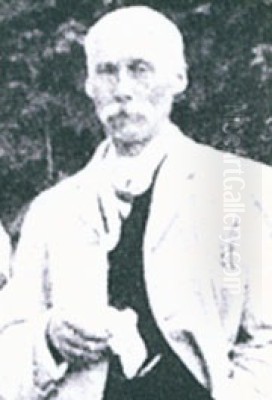
Albert Goodwin stands as a significant figure in the landscape of British art, a painter whose career spanned the latter half of the Victorian era and extended well into the twentieth century. Born in 1845 and passing away in 1932, Goodwin witnessed and absorbed profound changes in artistic styles and sensibilities. Primarily celebrated for his mastery of watercolour, he forged a unique path, blending the detailed observation championed by the Pre-Raphaelites with the atmospheric luminosity inspired by the great J.M.W. Turner. His work is a testament to a lifelong fascination with the natural world, enhanced by extensive travels and a poetic imagination that often imbued his landscapes with a sense of mystery and wonder. He remains renowned not just for his technical skill, but for his ability to capture the ephemeral qualities of light and weather, creating evocative scenes that resonate with viewers even today.
Early Life and Artistic Awakening in Kent
Albert Goodwin entered the world on January 17, 1845, in Maidstone, Kent. He was the eldest of nine children born to Samuel Goodwin, a builder or carpenter by trade. The Kentish landscape, with its rolling hills, meandering rivers, and historic towns, likely provided early inspiration for the budding artist. Though initially apprenticed to a local draper after his schooling, Goodwin's innate artistic talent could not be suppressed for long. His passion for drawing and painting quickly became evident, setting him on a different life course.
His precocious ability gained early recognition. Remarkably, at the tender age of fifteen, in 1860, Goodwin saw his first painting accepted for exhibition at the prestigious Royal Academy of Arts in London. This debut marked a significant milestone, launching a career that would span over seven decades. It was an auspicious start, hinting at the dedication and skill that would characterize his long artistic journey. This early success also brought him to the attention of influential figures in the art world, paving the way for crucial mentorship.
The Guiding Hands: Ruskin and the Pre-Raphaelites
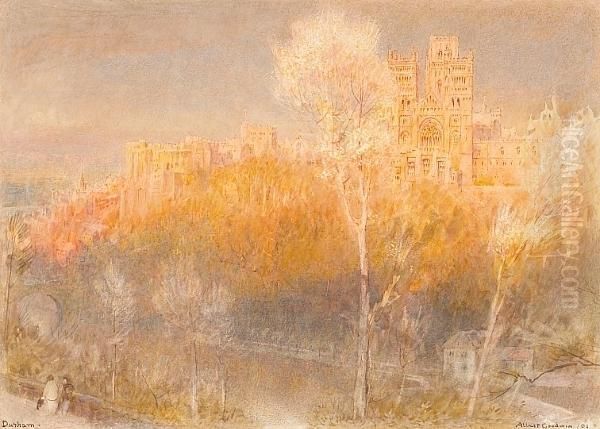
Goodwin's formative years were profoundly shaped by his association with key figures of the Pre-Raphaelite movement and the era's leading art critic, John Ruskin. He received formal instruction from Arthur Hughes and Ford Madox Brown, both prominent artists associated with the Pre-Raphaelite Brotherhood or its ideals. Hughes, known for his poetic and detailed depictions, and Brown, with his emphasis on realism and often complex compositions, provided Goodwin with a strong foundation in drawing, colour, and the Pre-Raphaelite ethos of 'truth to nature'. Their belief in his potential was reportedly strong, with predictions that he would become one of the great landscape painters of his time.
The connection with John Ruskin proved equally, if not more, pivotal. Ruskin, the influential writer, philosopher, and art critic, saw great promise in the young Goodwin. He took the artist under his wing, offering guidance, encouragement, and critical feedback. Ruskin's emphasis on meticulous observation of natural phenomena – cloud formations, geological structures, plant life – deeply resonated with Goodwin and became a cornerstone of his artistic practice throughout his life. Ruskin wasn't just a theoretical guide; he became a practical patron.
In 1872, Ruskin facilitated a significant journey for Goodwin, inviting him to travel to Italy alongside himself and potentially Arthur Hughes. This extended trip was not merely a holiday but an intensive period of study and sketching. Immersed in the landscapes, architecture, and light of Italy, Goodwin filled sketchbooks with detailed observations that would serve as source material for finished watercolours and oils for years to come. This experience, sponsored by Ruskin, broadened Goodwin's horizons immeasurably and solidified his commitment to landscape painting informed by direct experience. The influence of Ruskin and the Pre-Raphaelite circle, including figures like William Holman Hunt and Dante Gabriel Rossetti, instilled in Goodwin a respect for detail and craftsmanship that he carried throughout his career, even as his style evolved.
Forging a Personal Style: Turner, Light, and Innovation
While the Pre-Raphaelite emphasis on detail provided a foundation, Albert Goodwin's artistic vision was equally indebted to the legacy of J.M.W. Turner. He deeply admired Turner's revolutionary approach to light, colour, and atmosphere, particularly his ability to convey the power and sublimity of nature. Goodwin sought to emulate Turner's dramatic skies, his rendering of mist and water, and his overall sense of atmospheric envelopment. However, Goodwin was no mere imitator; he absorbed Turner's influence and integrated it into his own distinct style.
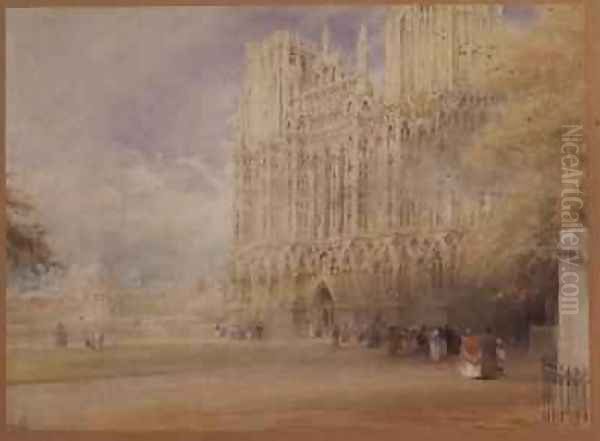
Goodwin became particularly renowned for his watercolours. He possessed a remarkable technical facility with the medium, capable of both precise rendering and broad, evocative washes. He wasn't afraid to experiment, especially in his later years. To capture the fleeting effects of light – dawn mists, twilight glows, stormy skies – he developed innovative techniques. He would often work watercolour over an initial pen-and-ink drawing, allowing the lines to provide structure. More distinctively, he sometimes applied bodycolour (gouache) or even oil paint sparingly over watercolour washes, and used techniques like blotting, scratching out, and sponging to achieve specific textures and luminous effects.
This combination of detailed observation, learned from his Pre-Raphaelite mentors and Ruskin, with the atmospheric concerns inspired by Turner, resulted in a style that was both descriptive and poetic. His landscapes often possess a dreamlike quality, a sense of heightened reality where the tangible world merges with the artist's imaginative response to it. He masterfully balanced topographical accuracy with emotional resonance, making his works more than just records of places, but interpretations of their spirit. His contemporaries in watercolour, like Myles Birket Foster or Helen Allingham, often focused on idyllic charm, whereas Goodwin frequently aimed for a deeper, more atmospheric and sometimes dramatic mood.
The World as a Studio: Travels Near and Far
Travel was not merely a pastime for Albert Goodwin; it was fundamental to his artistic practice and a constant source of inspiration. His journeys were extensive, taking him far beyond the shores of Britain. Following the pivotal trip to Italy in 1872, he returned to the continent frequently, exploring the landscapes of Switzerland, with its majestic Alps, and France. His travels weren't limited to Europe; his adventurous spirit led him much further afield.
He journeyed to Egypt, capturing the unique light and ancient monuments of the Nile Valley. He visited India, drawn by its vibrant colours, diverse landscapes, and iconic architecture like the Taj Mahal. His wanderlust also took him across the Atlantic to the United States and the West Indies, and even to the South Seas. These diverse experiences exposed him to a vast array of geographical features, climates, architectural styles, and qualities of light, all of which enriched his visual vocabulary.
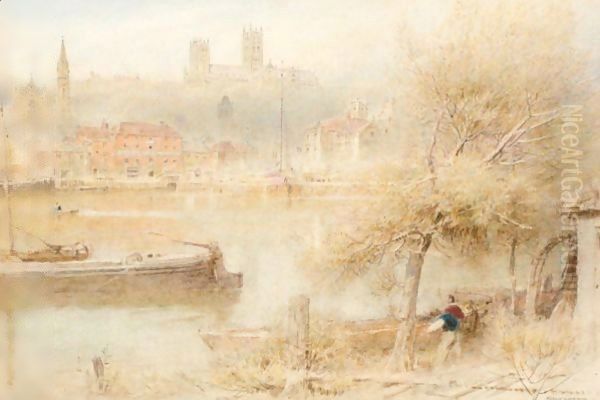
Within the British Isles, Goodwin was equally active. He painted extensively across England, Scotland, Wales, and Ireland. Coastal towns like Whitby, Hastings, and Rye, with their dramatic cliffs and bustling harbours, were favourite subjects. He captured the grandeur of cathedral cities such as Wells, Lincoln, and Durham, often depicting them bathed in ethereal morning or evening light. The tranquil beauty of the English countryside, the rugged mountains of Scotland and Wales, and the unique atmosphere of places like the Isle of Wight all found their way into his compositions. For Goodwin, sketching trips were essential; he would make numerous studies en plein air, capturing the immediate impression, which he would later work up into finished pieces in his studio, always striving to retain the initial spark of observation.
Masterworks and Recurring Themes
Albert Goodwin's prolific output includes numerous works now considered representative of his unique talent. His paintings often depict recognizable locations but are imbued with his characteristic blend of realism and romantic atmosphere.
Among his celebrated works is Amalfi, Venice (c. 1900), which, despite the slightly confusing title perhaps referring to the Amalfi coast and Venice as subjects he painted, showcases his ability to capture the unique interplay of water, architecture, and light in iconic locations. His depictions of Venice, like those of Turner before him, often emphasize the city's ethereal, dreamlike quality.
Architectural subjects were a recurring theme, treated with sensitivity to both structure and atmosphere. Durham Cathedral (c. 1910) is a fine example, portraying the massive Romanesque structure not just as a building, but as an integral part of the landscape, often shrouded in mist or bathed in dramatic light. Similarly, his views of Wells Cathedral, Lincoln Cathedral, and St. Paul's Cathedral in London demonstrate his skill in rendering complex architecture while prioritizing mood and light.
His earlier work, such as Old Bridge, Maidstone (1870), reflects his Pre-Raphaelite training with its detailed rendering, while still hinting at the atmospheric concerns that would dominate his later style. Coastal scenes were frequent subjects, with works depicting Whitby, Hastings, and Rye capturing the unique character of these English seaside towns, often under dramatic skies or in the soft light of dawn or dusk. A painting like Shipwreck off Whitby shows his ability to handle dramatic narrative within a landscape context.
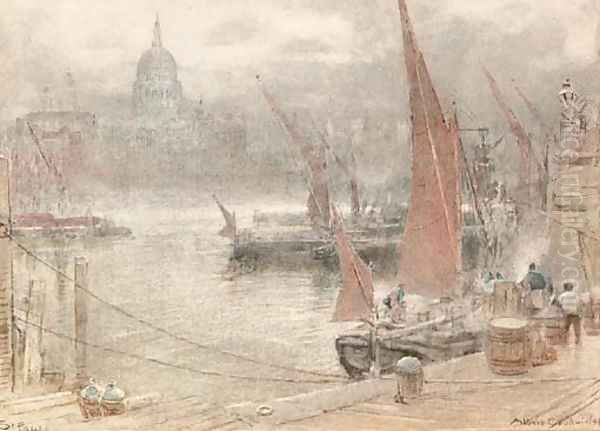
Beyond topographical views, Goodwin explored more imaginative and symbolic themes, sometimes drawing inspiration from literature, mythology, or the Bible. Works with titles suggesting allegorical or fantastical subjects, such as The Enchanted Lake or scenes inspired by Dante's Inferno or The Arabian Nights, reveal another dimension of his art, where landscape becomes a setting for narrative or spiritual contemplation. A Desert Oasis (c. 1900) reflects his travels to Egypt, combining observed detail with a sense of romantic exoticism. The sheer range of subjects, from the pastoral English countryside to the peaks of the Alps and the deserts of the Middle East, underscores the breadth of his vision and experience.
Professional Recognition and Exhibitions
Albert Goodwin achieved considerable recognition during his long career. His regular appearances at the Royal Academy exhibitions, starting from his teenage debut, established his presence in the London art world. However, he became particularly associated with the Royal Society of Painters in Water Colours (now the Royal Watercolour Society, RWS). He was elected an Associate of the RWS in 1871 and became a full Member in 1881. This affiliation was significant, as the RWS was the premier institution for watercolourists in Britain, and membership conferred considerable prestige.
He exhibited frequently at the RWS annual shows for decades, contributing hundreds of works over his lifetime. His watercolours were highly sought after by collectors. He also exhibited at other venues, including the Grosvenor Gallery and the New Gallery, and had numerous successful exhibitions at the Fine Art Society in London, a commercial gallery that played a crucial role in promoting the careers of many leading artists of the period.
His work was generally well-received by critics, who admired his technical skill, his poetic sensibility, and his ability to capture the nuances of landscape and atmosphere. While artistic tastes shifted towards Modernism in the later part of his career, Goodwin largely remained true to his own vision, rooted in the traditions of British landscape painting but infused with his personal style. His dedication to his craft and his consistent output ensured his reputation as one of the foremost watercolourists of his generation. Artists like Alfred William Hunt and John Brett, also known for detailed landscapes, were contemporaries whose work provides a context for Goodwin's own achievements, though Goodwin's style often incorporated a greater degree of atmospheric effect and imaginative interpretation.
A Network of Artists
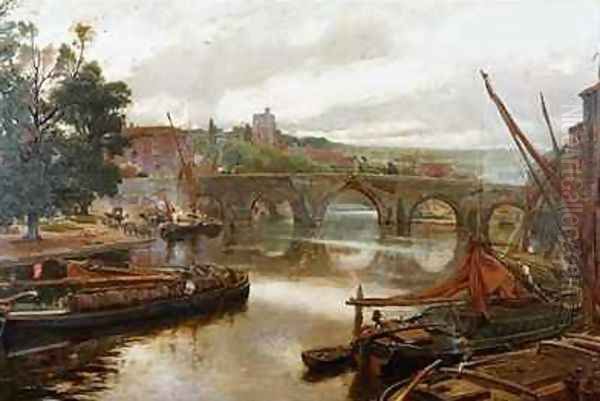
Albert Goodwin did not work in isolation. His training placed him directly within the orbit of the Pre-Raphaelite movement, connecting him not only with his teachers Arthur Hughes and Ford Madox Brown, but also with the broader circle that included figures like Dante Gabriel Rossetti, William Holman Hunt, John Everett Millais, and Edward Burne-Jones. His close relationship with John Ruskin further embedded him within a network of artists and intellectuals who valued detailed observation and the moral dimension of art.
His travels, particularly the trip to Italy with Ruskin and Hughes, provided opportunities for direct artistic exchange. While his style remained distinct, he would have been aware of the work of other prominent landscape painters of the era. The influence of J.M.W. Turner is undeniable, though Turner had passed away before Goodwin's career began. He exhibited alongside countless contemporaries at the Royal Academy and the RWS. These would have included traditional landscape painters, marine artists, and genre painters.
Comparisons can be drawn with other watercolourists who emphasized atmosphere, such as James Abbott McNeill Whistler, whose tonal harmonies, though different in technique, shared a concern for mood over literal description. The looser, more suggestive watercolour style of Hercules Brabazon Brabazon also presents an interesting contemporary parallel, representing a different path within the medium. Goodwin's work, however, consistently maintained a stronger link to topographical reality and detailed drawing, even in his most atmospheric pieces, distinguishing him from the more abstract tendencies of some contemporaries. His long career meant he also worked alongside later generations of artists, bridging the gap between High Victorianism and the early twentieth century.
Later Life and Enduring Legacy
Albert Goodwin remained remarkably productive throughout his long life, continuing to paint and travel well into his later years. His passion for capturing the beauty and mystery of the world around him never seemed to diminish. The experimental techniques he developed, particularly the combination of watercolour with ink and bodycolour, became more pronounced in his later work, allowing him to achieve ever more subtle and evocative effects of light and atmosphere. He continued to exhibit regularly, maintaining his presence in the art world.
Despite his dedication, the advancing years eventually took their toll on his health. Albert Goodwin passed away in London on April 10, 1932, at the age of 87. He left behind a vast body of work, estimated at over 800 paintings, primarily watercolours but also including oils. His legacy is that of a master watercolourist who successfully synthesized the detailed observation of the Pre-Raphaelite tradition with the atmospheric romanticism of Turner, creating a unique and highly personal vision of landscape.
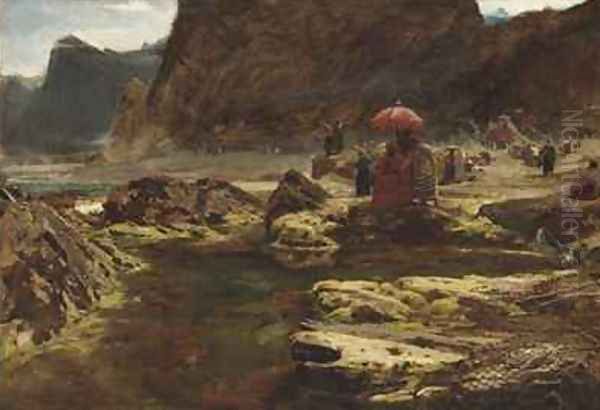
Today, his works are held in the collections of major museums and galleries across the United Kingdom and internationally. These include the Tate Britain, the Victoria and Albert Museum in London, the Ashmolean Museum in Oxford, the Birmingham Museum and Art Gallery, the Manchester Art Gallery, the National Museum of Wales, Maidstone Museum & Bentlif Art Gallery (in his hometown), and numerous regional galleries. His paintings also appear in collections in the United States, such as the Metropolitan Museum of Art in New York, attesting to his international reputation. He is remembered as a pivotal figure in the later tradition of British watercolour painting, an artist whose work continues to enchant viewers with its technical brilliance and poetic sensibility.
Conclusion: A Master of Mood and Place
Albert Goodwin's art offers a captivating journey through the landscapes of Britain and beyond, filtered through a sensibility that was both observant and deeply imaginative. He navigated the shifting artistic currents of his time, drawing inspiration from the meticulous detail of the Pre-Raphaelites and the sublime atmosphere of Turner, yet forging a style uniquely his own. His mastery of watercolour allowed him to capture the most elusive qualities of light and weather, transforming familiar scenes into evocative visions filled with mood and poetry. Through his extensive travels and prolific output, he created a rich and varied body of work that celebrates the beauty of the natural world while often hinting at deeper, more mysterious resonances. As a dedicated member of the Royal Watercolour Society and a widely exhibited artist, he achieved significant recognition in his lifetime, and his paintings continue to be admired for their technical skill, atmospheric depth, and enduring romantic appeal, securing his place as a distinguished and beloved figure in the history of British landscape art.